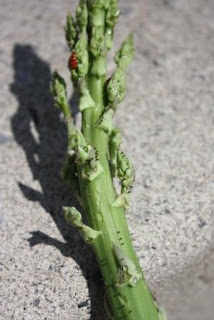I was surprised -- and pleased -- to see a few spears poking out from under the poppy leaves... until I got a bit closer.
What I first thought was lady birds turns out to be asparagus beetles. Yuck.

According to the University of Minnesota, there are two kinds of asparagus beetle: the common asparagus beetle (Crioceris asparagi) and the spotted asparagus beetle (Crioceris duodecimpunctata).
The common asparagus beetle, which is more prevalent and causes more damage, is bluish black with six cream coloured spots on its back. The spotted asparagus beetle is reddish-orange with twelve black spots, six on each wing. Both are 1/4-inch long.
We've got both species, though it appears we have more of the spotted variety. Lucky us.

The beetles feed on the asparagus spears, causing scarring and browning. They also devour the ferns, which appear later in the season.

Asparagus beetles overwinter in sheltered areas such as the hollow stems of old asparagus plants... or overgrown perennial gardens. Crap.
Common beetles lay lots of dark brown, oval-shaped eggs on the spears, ferns or buds and within a week, the larvae hatch and start feeding. Two weeks later, they fall to the ground to pupate in the soil and about a week later, the adults emerge to begin the cycle again.
 The spotted beetle has a similar life cycle but appears a bit later than the common beetle, arriving in mid-May and disappearing in late July. The eggs are greenish instead of brown.
The spotted beetle has a similar life cycle but appears a bit later than the common beetle, arriving in mid-May and disappearing in late July. The eggs are greenish instead of brown.Apparently, the best time to find the beetles is in the afternoon when they're most active, though I didn't have any trouble finding them in the morning. If you have a small crop, flicking the beetles into a pail of soapy water removes them and gives the owner of the crop a delicious sense of satisfaction. But you have to move fast -- those little blighters are quick.
If hand picking isn't your thing or if you don't have hours to track asparagus beetles armed with a trusty bucket of water, Tetrastichus asparagi, a tiny metallic green wasp parasitizes up to 70% of asparagus beetle eggs. Anyone know where I can find said parasitic wasp? Anyone?
Removing plant residue around the asparagus helps decrease the number of overwintering sites available to adults and should help decrease the population of beetles next season. Out of my three small patches, only one was affected and I'm thinking of removing it completely and establishing a new bed with the 20 asparagus roots we just purchased.
But first I've just got to dig me a great big trench. Any volunteers? Hello?





4 comments:
Not me, I just dug our new bed out by hand the other day, LOL! Sorry about the beetles, although you did a great ID post, so something good came of it!
Well, cwap! If it ain't one thing, it's another. Like who needs asparagus beetles??
Looks like quite the invasion. You might want to call the folks at Planet Natural (www.planetnatural.com) - they don't list tetrastichus on their predator insect page but they may know where to find them for you. And they ship beneficial insects free.
Erin -- okay, you're off the hook for trench duty :)
Mama Pea -- you're so right! Why can't all these nasty bugs just mind their manners and leave my veggies alone???
Thistledog -- if you think this invasion is bad, you should see my nemesis, the Japanese beetle. They are HORRENDOUS this year!! Grr. Thanks for the reference to Planet Natural -- how cool is that?!
Post a Comment